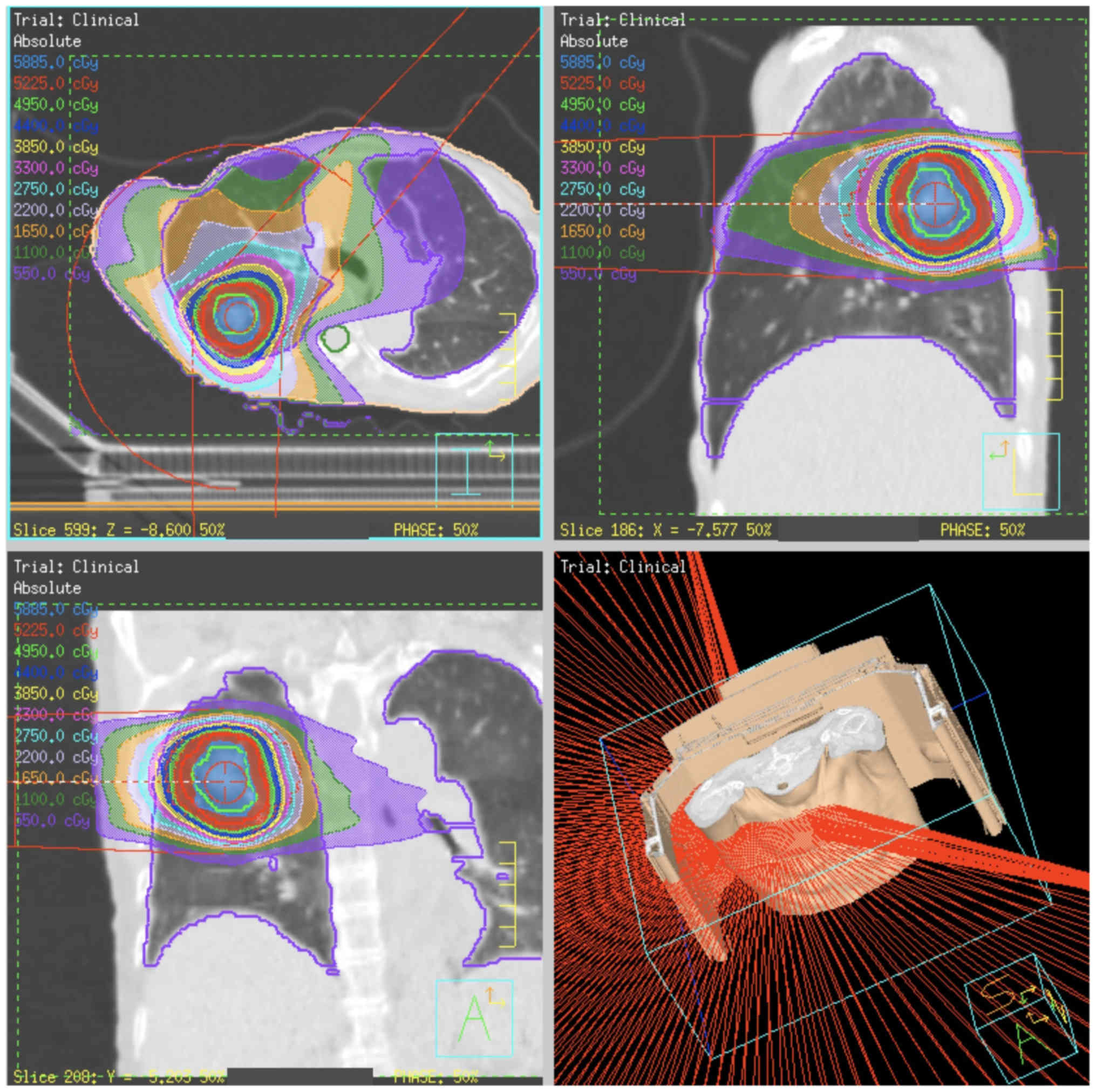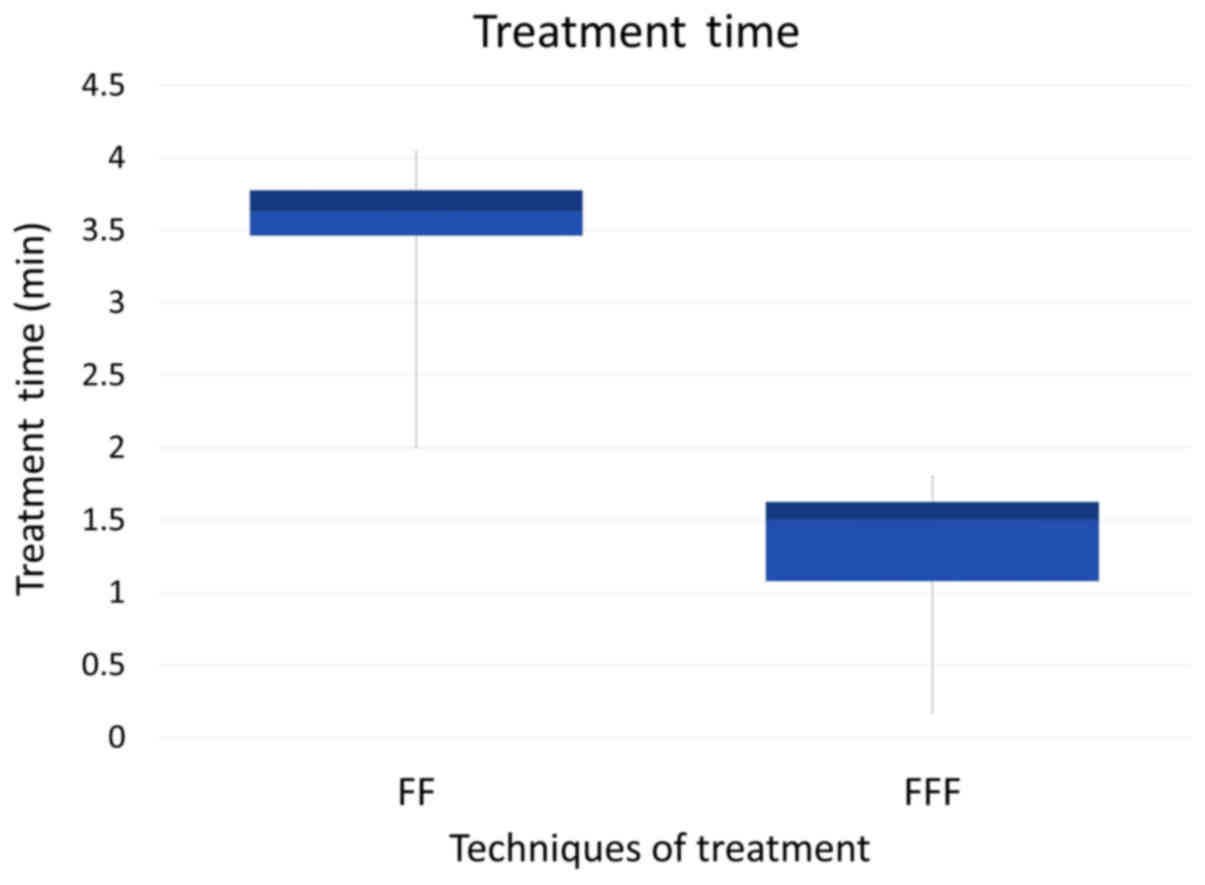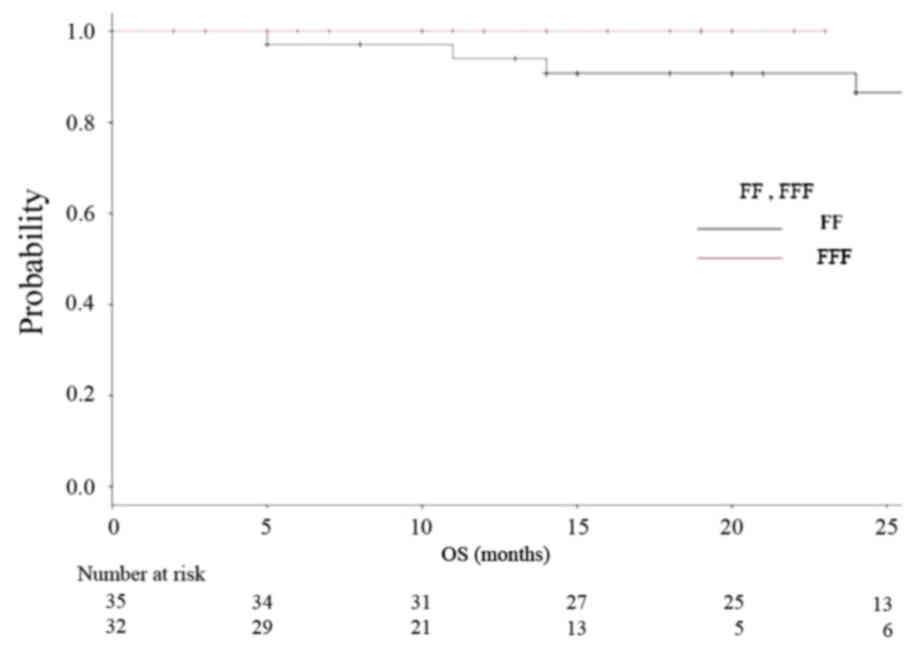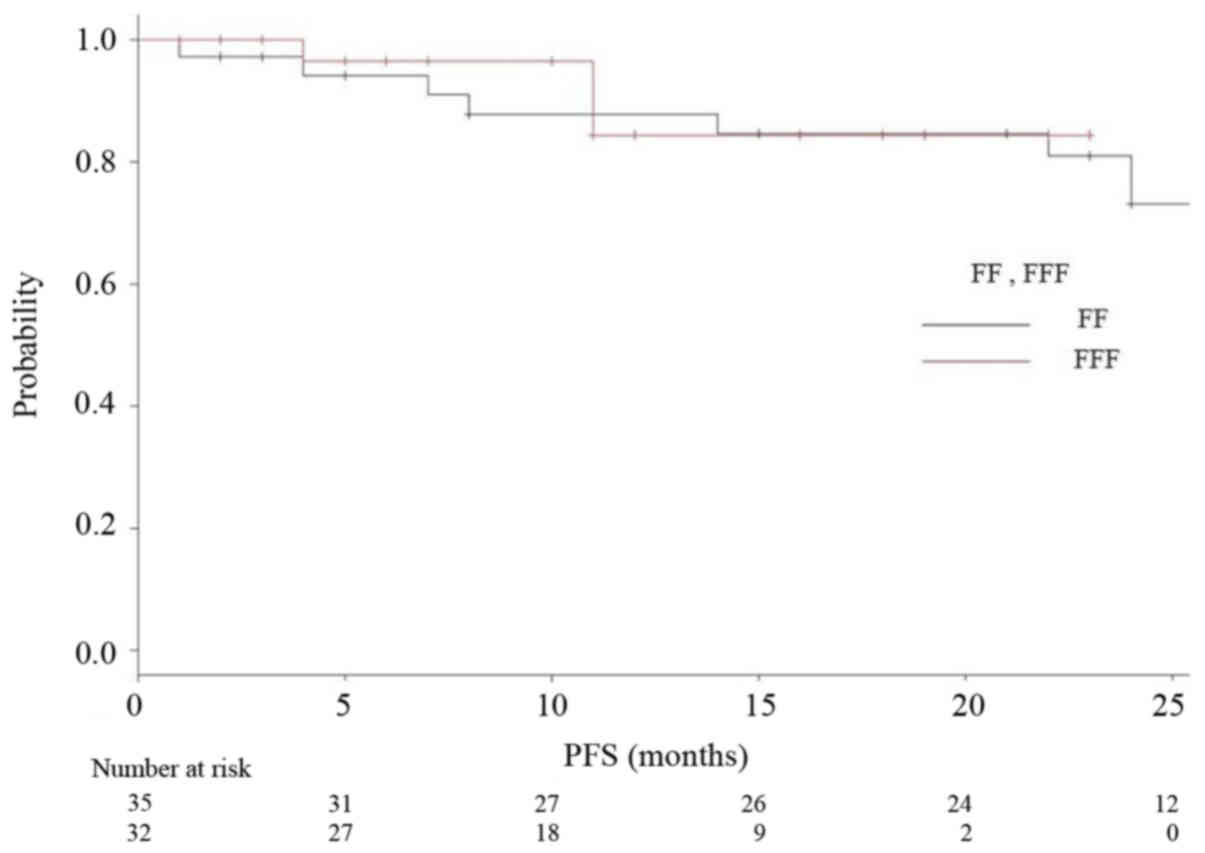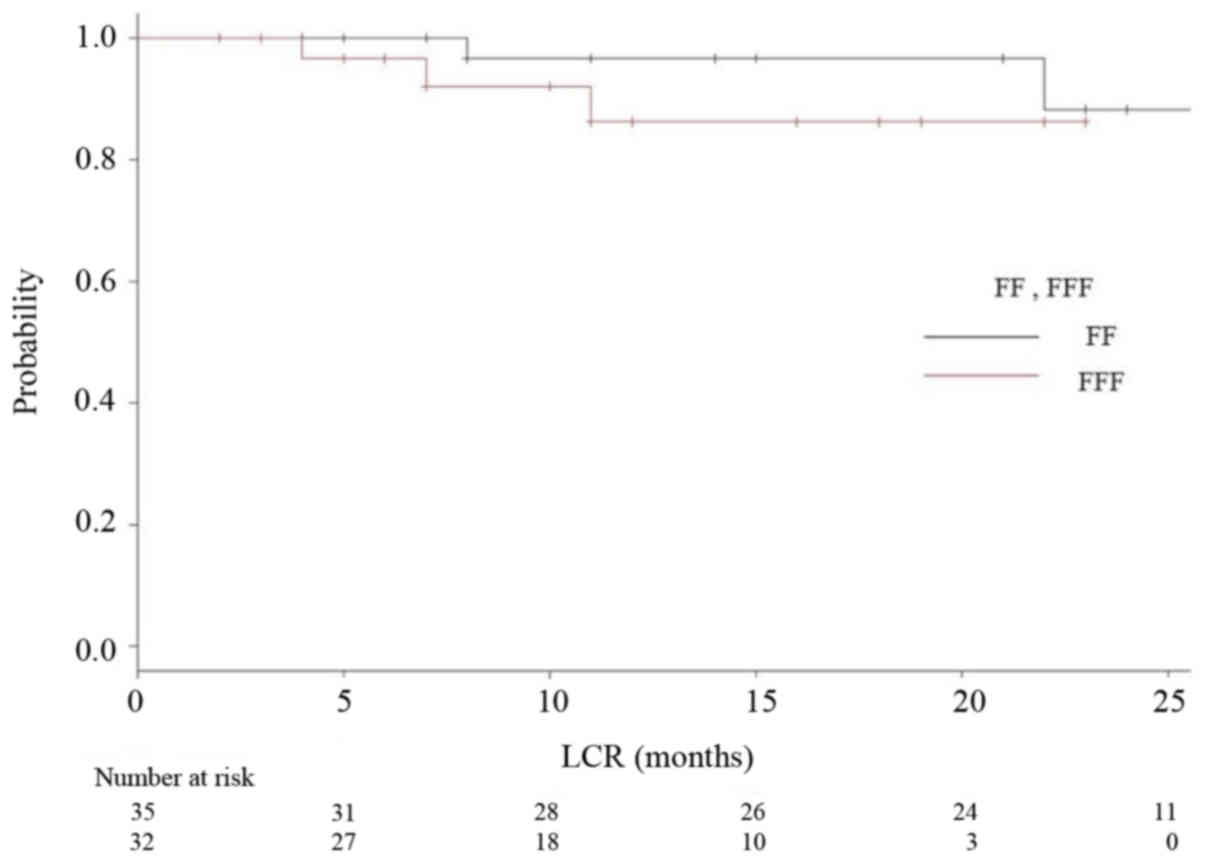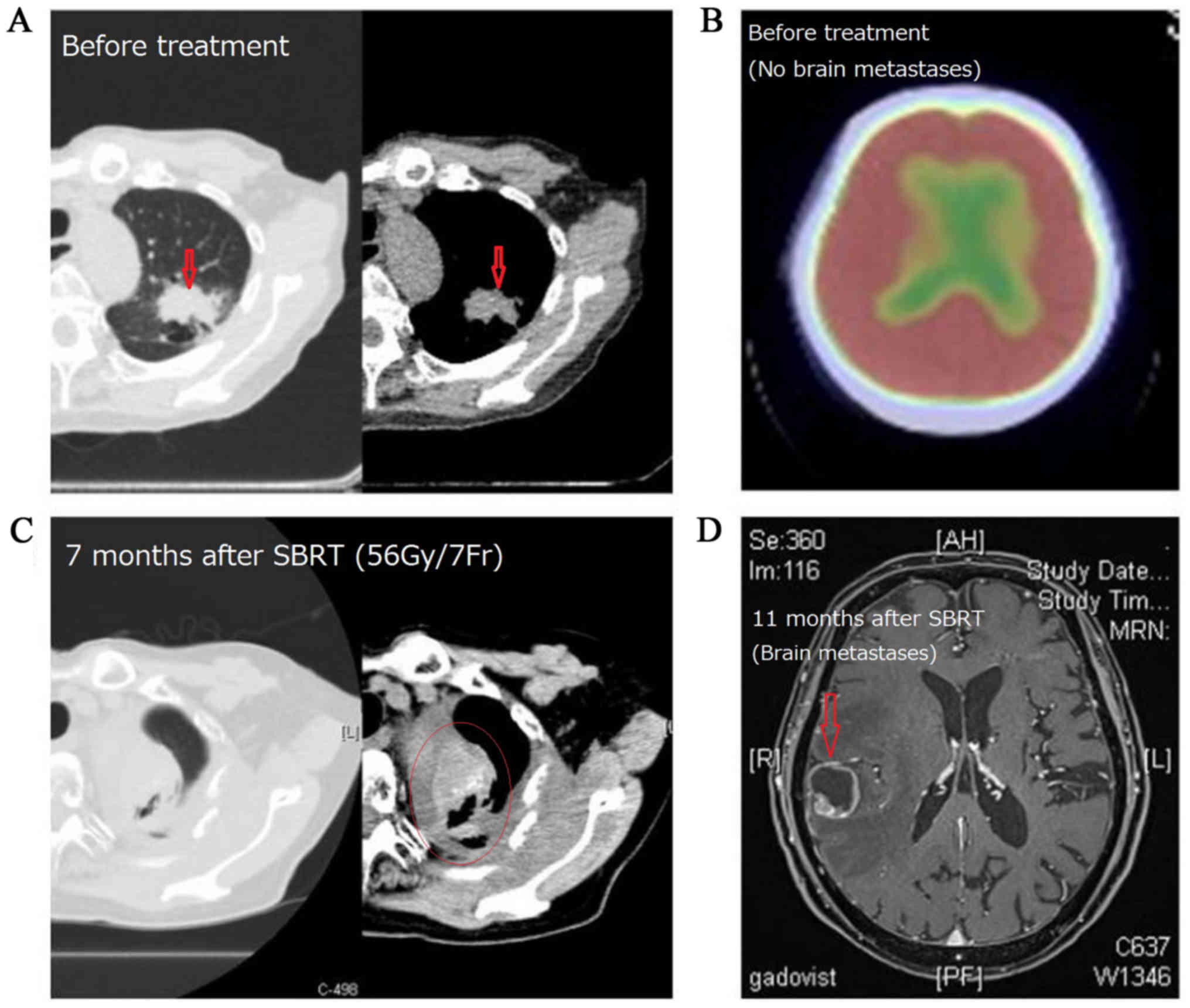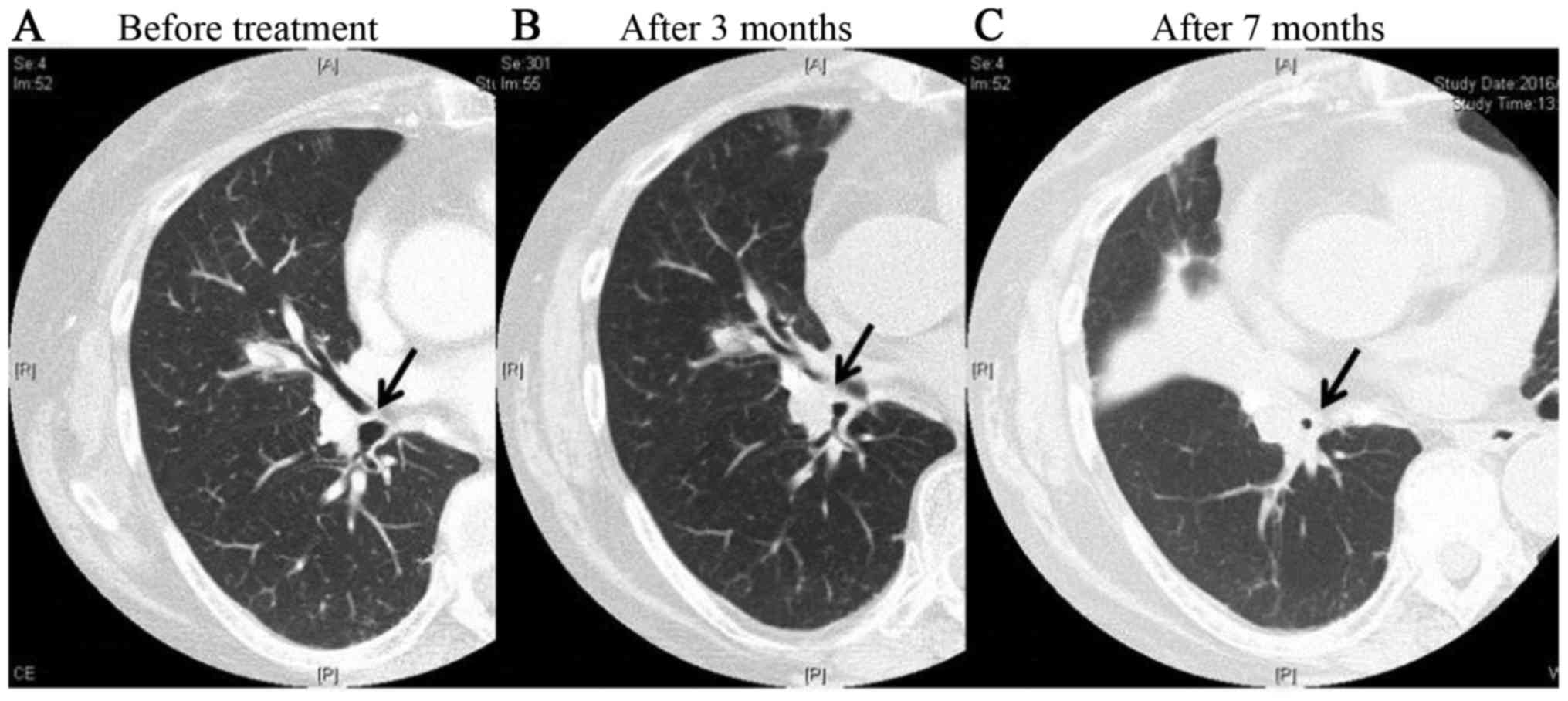|
1
|
Maquilan G and Timmerman R: Stereotactic
body radiation therapy for early-stage lung cancer. Cancer J.
22:274–279. 2016. View Article : Google Scholar : PubMed/NCBI
|
|
2
|
Ginsberg RJ and Rubinstein LV: Randomized
trial of lobectomy versus limited resection for T1 N0 non-small
cell lung cancer. Lung cancer study group. Ann Thorac Surg.
60:615–623. 1995. View Article : Google Scholar : PubMed/NCBI
|
|
3
|
Falkson CB, Vella ET, Yu E, El-Mallah M,
Mackenzie R, Ellis PM and Ung YC: Radiotherapy with curative intent
in patients with early-stage, medically inoperable, non-small-cell
lung cancer: A systematic review. Clin Lung Cancer. 18:105–121.e5.
2017. View Article : Google Scholar : PubMed/NCBI
|
|
4
|
Nanda RH, Liu Y, Gillespie TW, Mikell JL,
Ramalingam SS, Fernandez FG, Curran WJ, Lipscomb J and Higgins KA:
Stereotactic body radiation therapy versus no treatment for early
stage non-small cell lung cancer in medically inoperable elderly
patients: A National Cancer Data Base analysis. Cancer.
121:4222–4230. 2015. View Article : Google Scholar : PubMed/NCBI
|
|
5
|
Nagata Y, Hiraoka M, Shibata T, Onishi H,
Kokubo M, Karasawa K, Shioyama Y, Onimaru R, Kozuka T, Kunieda E,
et al: Prospective trial of stereotactic body radiation therapy for
both operable and inoperable T1N0M0 non-small cell lung cancer:
Japan Clinical Oncology Group Study JCOG0403. Int J Radiat Oncol
Biol Phys. 93:989–996. 2015. View Article : Google Scholar : PubMed/NCBI
|
|
6
|
Chang JY, Senan S, Paul MA, Mehran RJ,
Louie AV, Balter P, Groen HJ, McRae SE, Widder J, Feng L, et al:
Stereotactic ablative radiotherapy versus lobectomy for operable
stage I non-small-cell lung cancer: A pooled analysis of two
randomised trials. Lancet Oncol. 16:630–637. 2015. View Article : Google Scholar : PubMed/NCBI
|
|
7
|
Baumann P, Nyman J, Hoyer M, Wennberg B,
Gagliardi G, Lax I, Drugge N, Ekberg L, Friesland S, Johansson KA,
et al: Outcome in a prospective phase II trial of medically
inoperable stage I non-small-cell lung cancer patients treated with
stereotactic body radiotherapy. J Clin Oncol. 27:3290–3296. 2009.
View Article : Google Scholar : PubMed/NCBI
|
|
8
|
Niibe Y and Hayakawa K: Oligometastases
and oligo-recurrence: The new era of cancer therapy. Jpn J Clin
Oncol. 40:107–111. 2010. View Article : Google Scholar : PubMed/NCBI
|
|
9
|
Niibe Y and Chang JY: Novel insights of
oligometastases and oligo-recurrence and review of the literature.
Pulm Med. 2012:2610962012. View Article : Google Scholar : PubMed/NCBI
|
|
10
|
Yamashita H, Niibe Y, Yamamoto T, Katsui
K, Jingu K, Kanazawa S, Terahara A and Nakagawa K: Lung
stereotactic radiotherapy for oligometastases: Comparison of
oligo-recurrence and sync-oligometastases. Jpn J Clin Oncol.
46:687–691. 2016. View Article : Google Scholar : PubMed/NCBI
|
|
11
|
Niibe Y, Yamashita H, Sekiguchi K,
Takahashi W, Shiraishi K, Okuma K, Terahara A, Kawamori J and
Nakagawa K: Stereotactic body radiotherapy results for pulmonary
oligometastases: A two-institution collaborative investigation.
Anticancer Res. 35:4903–4908. 2015.PubMed/NCBI
|
|
12
|
Pasqualetti F, Montrone S, Vivaldi C, Zani
M, Fedele D, Fornaro L, Pasqualetti G, Salvatore L, Manfredi B,
Laliscia C, et al: Stereotactic body radiotherapy in patients with
lung oligometastases from colorectal cancer. Anticancer Res.
37:315–319. 2017. View Article : Google Scholar : PubMed/NCBI
|
|
13
|
Zhang JY, Lu JY, Wu LL, Hong DL, Ma CC,
Peng X and Lin ZX: A dosimetric and treatment efficiency evaluation
of stereotactic body radiation therapy for peripheral lung cancer
using flattening filter free beams. Oncotarget. 7:73792–73799.
2016.PubMed/NCBI
|
|
14
|
Rieber J, Tonndorf-Martini E, Schramm O,
Rhein B, König L, Adeberg S, Meyerhof E, Mohr A, Kappes J, Hoffmann
H, et al: Establishing stereotactic body radiotherapy with
flattening filter free techniques in the treatment of pulmonary
lesions-initial experiences from a single institution. Radiat
Oncol. 11:802016. View Article : Google Scholar : PubMed/NCBI
|
|
15
|
Hoogeman MS, Nuyttens JJ, Levendag PC and
Heijmen BJ: Time dependence of intrafraction patient motion
assessed by repeat stereoscopic imaging. Int J Radiat Oncol Biol
Phys. 70:609–618. 2008. View Article : Google Scholar : PubMed/NCBI
|
|
16
|
Takahashi W, Yamashita H, Kida S, Masutani
Y, Sakumi A, Ohtomo K, Nakagawa K and Haga A: Verification of
planning target volume settings in volumetric modulated arc therapy
for stereotactic body radiation therapy by using in-treatment
4-dimensional cone beam computed tomography. Int J Radiat Oncol
Biol Phys. 86:426–431. 2013. View Article : Google Scholar : PubMed/NCBI
|
|
17
|
Stieler F, Fleckenstein J, Simeonova A,
Wenz F and Lohr F: Intensity modulated radiosurgery of brain
metastases with flattening filter-free beams. Radiother Oncol.
109:448–451. 2013. View Article : Google Scholar : PubMed/NCBI
|
|
18
|
Timmerman RD, Paulus R, Galvin J,
Michalski J, Straube W, Bradley J, Fakiris A, Bezjak A, Videtic G,
Johnstone D, et al: Stereotactic body radiation therapy for
medically inoperable early stage lung cancer. JAMA. 303:1070–1076.
2010. View Article : Google Scholar : PubMed/NCBI
|
|
19
|
Roesch J, Panje C, Sterzing F, Mantel F,
Nestle U, Andratschke N and Guckenberger M: SBRT for centrally
localized NSCLC-What is too central? Radiat Oncol. 11:1572016.
View Article : Google Scholar : PubMed/NCBI
|
|
20
|
Yamashita H, Takahashi W, Haga A, Kida S,
Saotome N and Nakagawa K: Stereotactic body radiotherapy for small
lung tumors in the University of Tokyo hospital. Biomed Res Int.
2014:1365132014. View Article : Google Scholar : PubMed/NCBI
|
|
21
|
Nakagawa K, Haga A, Kida S, Masutani Y,
Yamashita H, Takahashi W, Sakumi A, Saotome N, Shiraki T, Ohtomo K,
et al: 4D registration and 4D verification of lung tumor position
for stereotactic volumetric modulated arc therapy using
respiratory-correlated cone-beam CT. J Radiat Res. 54:152–156.
2013. View Article : Google Scholar : PubMed/NCBI
|
|
22
|
Nakagawa K, Haga A, Sakumi A, Yamashita H,
Igaki H, Shiraki T, Ohtomo K, Iwai Y and Yoda K: Impact of
flattening-filter-free techniques on delivery time for lung
stereotactic volumetric modulated arc therapy and image quality of
concurrent kilovoltage cone-beam computed tomography: A preliminary
phantom study. J Radiat Res. 55:200–202. 2014. View Article : Google Scholar : PubMed/NCBI
|
|
23
|
Yamashita H, Haga A, Takahashi W, Takenaka
R, Imae T, Takenaka S and Nakagawa K: Volumetric modulated arc
therapy for lung stereotactic radiation therapy can achieve high
local control rates. Radiat Oncol. 9:2432014. View Article : Google Scholar : PubMed/NCBI
|
|
24
|
Dvorak P, Georg D, Bogner J, Kroupa B,
Dieckmann K and Pötter R: Impact of IMRT and leaf width on
stereotactic body radiotherapy of liver and lung lesions. Int J
Radiat Oncol Biol Phys. 61:1572–1581. 2005. View Article : Google Scholar : PubMed/NCBI
|
|
25
|
Haga A, Kida S, Saotome N, Takahashi W,
Yamashita H, Masutani Y, et al Others: Four-dimensional Cone-Beam,
: CT During SBRTStereotactic Body Radiation Therapy. Springer;
Tokyo: pp. 225–236. 2015, View Article : Google Scholar
|
|
26
|
Miura H, Ozawa S, Hosono F, Sumida N,
Okazue T, Yamada K and Nagata Y: Gafchromic EBT-XD film: Dosimetry
characterization in high-dose, volumetric-modulated arc therapy. J
Appl Clin Med Phys. 17:312–322. 2016. View Article : Google Scholar : PubMed/NCBI
|
|
27
|
Navarria P, Ascolese AM, Mancosu P, Alongi
F, Clerici E, Tozzi A, Iftode C, Reggiori G, Tomatis S, Infante M,
et al: Volumetric modulated arc therapy with flattening filter free
(FFF) beams for stereotactic body radiation therapy (SBRT) in
patients with medically inoperable early stage non small cell lung
cancer (NSCLC). Radiother Oncol. 107:414–418. 2013. View Article : Google Scholar : PubMed/NCBI
|
|
28
|
Prendergast BM, Fiveash JB, Popple RA,
Clark GM, Thomas EM, Minnich DJ, Jacob R, Spencer SA, Bonner JA and
Dobelbower MC: Flattening filter-free linac improves treatment
delivery efficiency in stereotactic body radiation therapy. J Appl
Clin Med Phys. 14:41262013. View Article : Google Scholar : PubMed/NCBI
|
|
29
|
Lang S, Shrestha B, Graydon S, Cavelaars
F, Linsenmeier C, Hrbacek J, Klöck S, Studer G and Riesterer O:
Clinical application of flattening filter free beams for
extracranial stereotactic radiotherapy. Radiother Oncol.
106:255–259. 2013. View Article : Google Scholar : PubMed/NCBI
|
|
30
|
Zhang GG, Ku L, Dilling TJ, Stevens CW,
Zhang RR, Li W and Feygelman V: Volumetric modulated arc planning
for lung stereotactic body radiotherapy using conventional and
unflattened photon beams: A dosimetric comparison with 3D
technique. Radiat Oncol. 6:1522011. View Article : Google Scholar : PubMed/NCBI
|
|
31
|
Macchia G, Deodato F, Cilla S, Cammelli S,
Guido A, Ferioli M, Siepe G, Valentini V, Morganti AG and
Ferrandina G: Volumetric modulated arc therapy for treatment of
solid tumors: Current insights. Onco Targets Ther. 10:3755–3772.
2017. View Article : Google Scholar : PubMed/NCBI
|
|
32
|
Nakagawa K, Haga A, Shiraishi K, Yamashita
H, Igaki H, Terahara A, Ohtomo K, Saegusa S, Shiraki T, Oritate T
and Yoda K: First clinical cone-beam CT imaging during volumetric
modulated arc therapy. Radiother Oncol. 90:422–423. 2009.
View Article : Google Scholar : PubMed/NCBI
|
|
33
|
Holt A, van Vliet-Vroegindeweij C, Mans A,
Belderbos JS and Damen EM: Volumetric-modulated arc therapy for
stereotactic body radiotherapy of lung tumors: A comparison with
intensity-modulated radiotherapy techniques. Int J Radiat Oncol
Biol Phys. 81:1560–1567. 2011. View Article : Google Scholar : PubMed/NCBI
|
|
34
|
Deodato F, Cilla S, Macchia G, Caravatta
L, Mignogna S, Massaccesi M, Picardi V, Digesu C, Sallustio G,
Bonomo P, et al: Extracranial radiosurgery with volumetric
modulated arc therapy: Feasibility evaluation of a phase I trial.
Oncol Lett. 5:1889–1896. 2013. View Article : Google Scholar : PubMed/NCBI
|
|
35
|
Nakagawa K, Kida S, Haga A, Masutani Y,
Yamashita H, Onoe T, Imae T, Tanaka K, Ohtomo K and Yoda K: 4D
digitally reconstructed radiography for verifying a lung tumor
position during volumetric modulated arc therapy. J Radiat Res.
53:628–632. 2012. View Article : Google Scholar : PubMed/NCBI
|
|
36
|
Thomas EM, Popple RA, Prendergast BM,
Clark GM, Dobelbower MC and Fiveash JB: Effects of flattening
filter-free and volumetric-modulated arc therapy delivery on
treatment. Efficiency. 14:43282013.
|
|
37
|
Cashmore J: The characterization of
unflattened photon beams from a 6 MV linear accelerator. Phys Med
Biol. 53:1933–1946. 2008. View Article : Google Scholar : PubMed/NCBI
|
|
38
|
Vassiliev ON, Titt U, Pönisch F, Kry SF,
Mohan R and Gillin MT: Dosimetric properties of photon beams from a
flattening filter free clinical accelerator. Phys Med Biol.
51:1907–1917. 2006. View Article : Google Scholar : PubMed/NCBI
|
|
39
|
Kinj R, Bondiau PY, François E, Gérard JP,
Naghavi AO, Leysalle A, Chamorey E, Evesque L, Padovani B, Ianessi
A, et al: Radiosensitivity of colon and rectal lung oligometastasis
treated with stereotactic ablative radiotherapy. Clin Colorectal
Cancer. 16:e211–e220. 2016. View Article : Google Scholar : PubMed/NCBI
|
|
40
|
Rieber J, Tonndorf-Martini E, Schramm O,
Rhein B, König L, Adeberg S, Meyerhof E, Mohr A, Kappes J and
Hoffmann H: Establishing stereotactic body radiotherapy with
flattening filter free techniques in the treatment of pulmonary
lesions-initial experiences from a single institution. Radiat
Oncol. 11:802016. View Article : Google Scholar : PubMed/NCBI
|
|
41
|
Prendergast BM, Dobelbower MC, Bonner JA,
Popple RA, Baden CJ, Minnich DJ, Cerfolio RJ, Spencer SA and
Fiveash JB: Stereotactic body radiation therapy (SBRT) for lung
malignancies: Preliminary toxicity results using a flattening
filter-free linear accelerator operating at 2,400 monitor units per
minute. Radiat Oncol. 8:2732013. View Article : Google Scholar : PubMed/NCBI
|
|
42
|
Timmerman R, McGarry R, Yiannoutsos C,
Papiez L, Tudor K, DeLuca J, Ewing M, Abdulrahman R, DesRosiers C,
Williams M and Fletcher J: Excessive toxicity when treating central
tumors in a phase II study of stereotactic body radiation therapy
for medically inoperable early-stage lung cancer. J Clin Oncol.
24:4833–4839. 2006. View Article : Google Scholar : PubMed/NCBI
|
|
43
|
Roesch J, Panje C, Sterzing F, Mantel F,
Nestle U, Andratschke N and Guckenberger M: SBRT for centrally
localized NSCLC-What is too central? Radiat Oncol. 11:1572016.
View Article : Google Scholar : PubMed/NCBI
|
|
44
|
Kimura T, Nagata Y, Eba J, Ozawa S,
Ishikura S, Shibata T, Ito Y, Hiraoka M and Nishimura Y; Radiation
Oncology Study Group of the Japan Clinical Oncology Group, : A
randomized Phase III trial of comparing two dose-fractionations
stereotactic body radiotherapy (SBRT) for medically inoperable
Stage IA non-small cell lung cancer or small lung lesions
clinically diagnosed as primary lung cancer: Japan Clinical
Oncology Group Study JCOG1408 (J-SBRT trial). Jpn J Clin Oncol.
2017.(Epub ahead of print). View Article : Google Scholar
|















